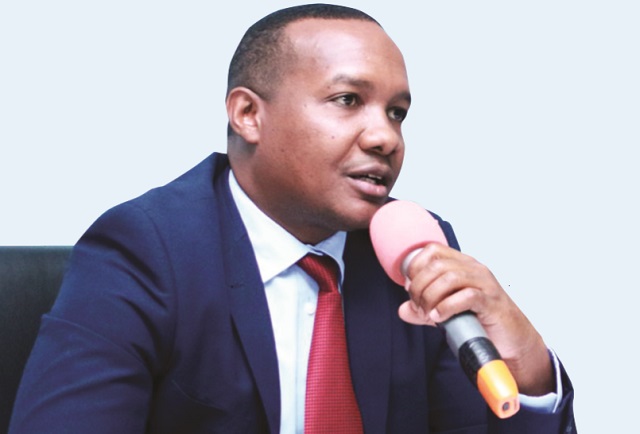
Uganda Securities Exchange tells manufacturers recovering from COVID-19 pandemic stress
Kampala, Uganda | JULIUS BUSINGE | As manufacturers weather the tough times caused by COVID-19 lockdown and related restrictions, executives at the Uganda Securities Exchange say, doors are open for raising capital to reboot business activities.
Speaking on behalf of the USE Chief Executive Officer at a virtual meeting titled ‘diversifying financing sources for manufacturers’ on Oct.07, Alison Kwikiriza Serucaca, said the bourse maintains its stance on providing a platform for companies to access capital for future financing opportunities, enhancing market value for companies and accessing institutional and professional investors, improving liquidity for shareholders and boosting business efficiency in line with disclosures. The other opportunities have to do with increased brand equity locally and in the EAC region.
There are three investment market segments for manufacturers to exploit on the Nakawa based market. One is the ‘main investment market segment’ which is the largest platform the exchange offers for entities.
“All generic benefits of financing using equity exist on this platform,” Kwikiriza said. She added that unique to the USE are the tax benefits, prestige, a better investment rating and a resultant ability to generate unlimited finance from investors.
The other market segment is ‘growth enterprises market segment.’ This targets companies that have ability to grow revenues.
Kwikiriza said, these could be mature entities or companies in the startup phase as long as there are strong prospects of acceleration in growth once funds are received.
Unlike conditions or requirements for listing on the MIMS, the requirements for GEMS are more relaxed. This segment targets small and medium enterprises that form the majority of Ugandan enterprises. But it is yet to boom as companies continue to deal with changes in their business plans.
The other market segment is ‘fixed income securities market’ which is a platform for fixed income/government securities.
This market aims at providing a separate independent market for companies wishing to raise financing through issuance and listing of fixed income securities such as treasury bonds, corporate bonds, preference shares and debenture stocks.
It also provides the market for investors wishing to trade securities at the exchange.
The current value proposition for the USE has 17 listed companies, of which eight are cross listed on the other EAC securities exchange especially the Nairobi market.
It has 65 treasury and corporate bonds. Total capital raised so far is Shs2.2trillion, of this amount, initial public offers account for Shs1.4trillion, secondary market offers account for Shs559bn and corporate bonds account for Shs280bn.
The IPO process takes 6-8 months depending on the type of the company that has to be scrutinised for this purpose.
Leah Nyambura, an investment banker from Dyer and Blair [dealers in investment banking, brokerage services and wealth management] said access to finance by manufacturers is the backbone of any business because it affects survival, profit growth and sustainability of any company or business.
She added that financing options available for manufacturers include raising funds through IPOs, and listings on USE plus subsequent public issuances such as secondary IPOs and rights issues. Corporate debt, with a focus on corporate bond issue and its listing on USE is the other avenue for resource mobilisation.
In addition, Nyambura said manufacturers could think of mobilising resources internally from their available excess cash, retained earnings or by directly injecting new equity/capital in the business.
Externally, they could access financing through bank loans, corporate debt and private equity (strategic investors).
Nyambura urges manufacturers to maintain good credit quality and financial records using recognised audit firms and a good public profile/brand strength. They should also have relatively low debt and stable earnings with an executive board and management team.
Experts back the idea of supporting manufacturers since they play an important role in growing the economy through job creation, value addition, export promotion and tax contribution to government.
Barbra Mulwana, the chairperson for Uganda Manufacturers Association (UMA), said her members were open to financing solutions offered in the capital markets space. According to Uganda Bureau of Statistics (Ubos) data, Uganda has a total of 4, 920 manufacturers contributing approx.40% to GDP.
Of this total number, 1% are large manufacturers, 7% are medium sized and 92% are Small and Medium Enterprises. The Gross Enterprise Market on the USE targets the 92% category of manufacturers that have largely remained outside of the USE market.
Most of these, according to Mulwana are family owned and have not taken interest to mobilise resources outside their current sources. Mulwana said, the capital markets authorities should study carefully these businesses (the 92% category) and offer them relaxed, fair terms and conditions as a motivation move for listing on the bourse.
“We all need affordable capital to enable us expand,” Mulwana said, adding: “We need local solutions for our manufacturers.” Apart from financing options, she said the government through the capital markets should reboot their businesses through tax incentives and related opportunities to enable ‘us grow more and move our country forward.”
Only four large manufacturing firms are currently listed on the USE; British American Tobacco (BATU), Uganda Clays Limited (UCL), Cipla Quality Chemical Industries (CQCIL) and East African Breweries (EABL).
****
 The Independent Uganda: You get the Truth we Pay the Price
The Independent Uganda: You get the Truth we Pay the Price


